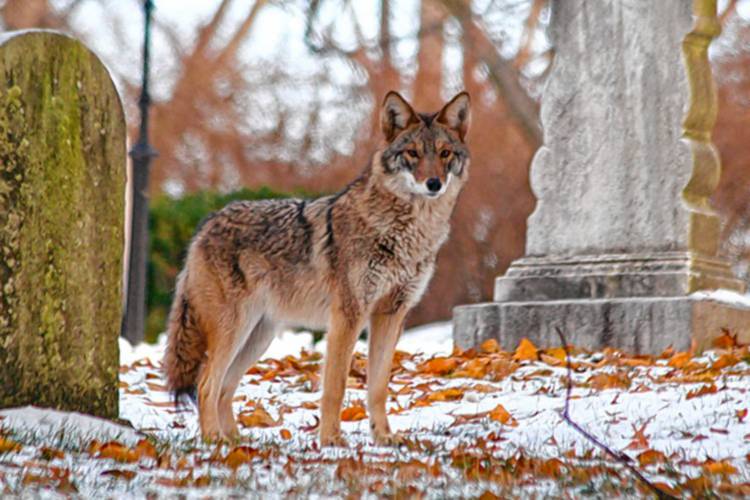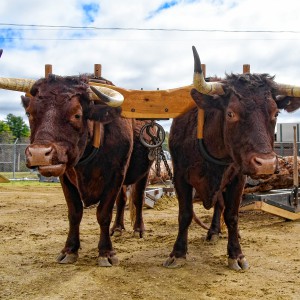Take Me Outside: Eastern coyotes – scary neighbors or important managers?

A coyote stands in Mount Auburn Cemetery in Cambridge, Mass. Coyotes have lived in the East since the 1930s. JOSH HARRISON / via AP
| Published: 02-25-2024 6:00 AM |
A few weeks ago my friend, fellow Monitor columnist and local farmer, Carole Soule shared a story about coyotes on her farm. Though I’m not a commercial farmer, I sympathize with the angst Carole felt about sharing her farm with canine predators. I own a small flock of chickens and know whenever they are out of their pen, they are at risk of becoming prey.
Yet as a naturalist I appreciate knowing that the habitat around me supports a wide variety of wildlife. Predators like coyotes, foxes, and bobcats are part of a healthy ecosystem. They play an important role by keeping the smaller animals from becoming overpopulated. This can be helpful to farmers since rodents and other herbivores often consume a great deal of livestock feed and produce from gardens.
Eastern coyotes are opportunistic when it comes to finding food. They will consume small to mid-sized mammals such as mice, voles, squirrels, rabbits and beavers. Fawns are an important selection in spring and summer. Injured adult deer may be taken on occasion. Birds, amphibians, reptiles, fish and even insects also make up part of their diet. Despite being called canines, they are not strictly meat eaters. Fruits, nuts, and vegetables are consumed, when in season.
A diverse menu is one of the adaptations that helped coyotes expand their territory. They did not exist in the eastern states until the mid-1940s. According to the NH Fish and Game Department, the “first verified account of a coyote in New Hampshire was in Grafton County, in 1944.” They had migrated from midwestern states to fill the void that was being created by declining populations of larger predators.
Before European settlers arrived to what is now the northeastern United States, wolves and mountain lions inhabited the woodlands. With the conversion of forested landscape to farmland, wolves and lions lost their habitat and natural prey species. Open land and domestic livestock replaced their home range and typical food sources. To survive, the predators shifted to sheep and cattle for food. Obviously, farmers were not happy and hunted the predators with abandon.
Westward expansion of farmers led to westward reduction in predators. As the numbers of wolves and wild cats decreased, western coyotes moved into the territory and filled the niche left by the once dominant larger hunters. Declining wolves in the Great Lakes area left any remaining ones desperate for mates. When east bound coyotes encountered wolves they occasionally would interbreed. The resulting offspring were larger than the western coyotes because of the added wolf genes. They continued to move east and south through New York state, entering New England and expanding their range.
A DNA study of 462 eastern coyotes conducted at Stonybrook University in New York, indicates that the average genetic breakdown was 64% coyote, 13% Canadian gray wolf, 13% eastern wolf, and 10% domestic dog. Eastern coyotes are typically 30-45 pounds. Their western cousins weigh in at 25-40 pounds. Both breeds of coyote are small compared to eastern wolf. Wolves can weigh 70-120 pounds and are nearly twice as tall as coyotes.
If you see a wild canine in New Hampshire and it seems large, you can distinguish a coyote from a wolf because the wolves hold their tails high when they run, coyote tails hang low between their legs. The other way to identify what you are seeing is that we have no wolves in our state. They were extirpated (regionally eliminated) in the late 1890’s.
Article continues after...
Yesterday's Most Read Articles
Coyotes on the other hand, can be seen throughout the state, in various habitats, including urban areas. They may be seen alone or in small packs consisting of an adult pair and their offspring. Yearlings may disperse from their parents or stay to help raise the next litter of pups which are born in May.
More common than sightings, coyotes make their presence known through howls, yelps and high- pitched cries. Vocalizations are a way to stay in touch with each other and communicate over distances especially at night or during dawn and dusk.
Some people find these sounds and coyote presence to be eerie, and scary. When I hear them, I appreciate their adaptiveness and hope they will enjoy the rodents around my property.


 Celebrate agriculture, education, and community at the NH Farm, Forest, and Garden Expo
Celebrate agriculture, education, and community at the NH Farm, Forest, and Garden Expo Community Players of Concord present newest adaptation of Pride and Prejudice
Community Players of Concord present newest adaptation of Pride and Prejudice Concord Monitor editor Mike Pride’s final book explores the lives, works of Northern New England poets
Concord Monitor editor Mike Pride’s final book explores the lives, works of Northern New England poets Active Aging: John Burke of Peterborough celebrated his 81st birthday with 81 hikes up Pack Monadnock
Active Aging: John Burke of Peterborough celebrated his 81st birthday with 81 hikes up Pack Monadnock
